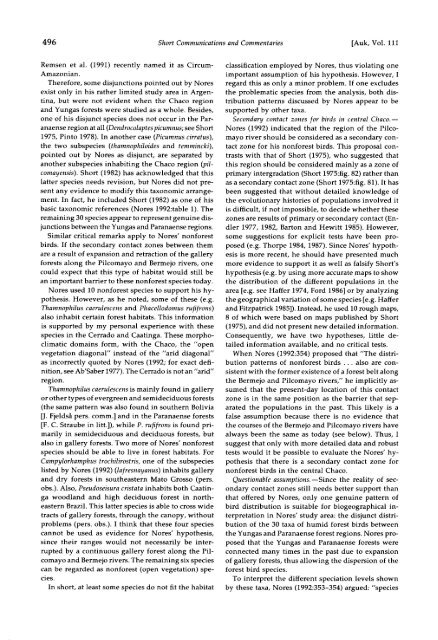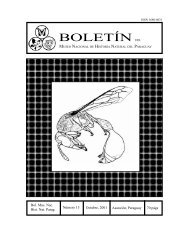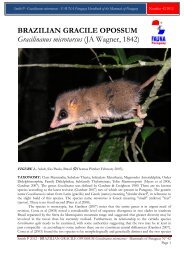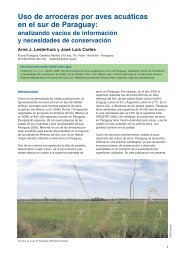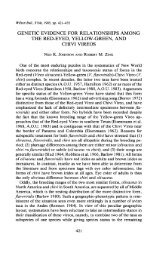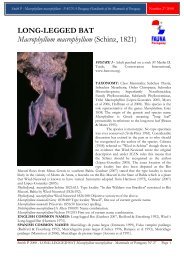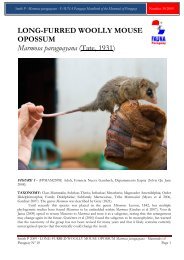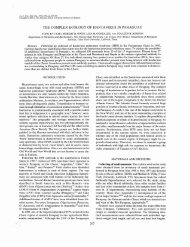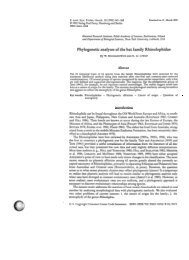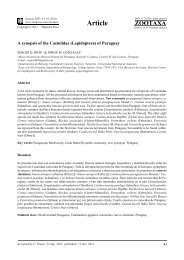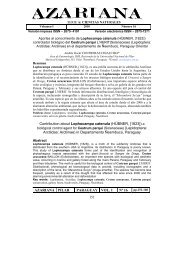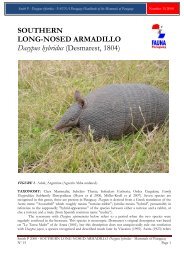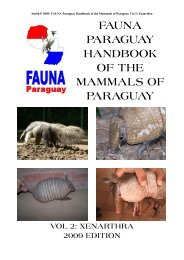Download pdf 446KB - FAUNA Paraguay
Download pdf 446KB - FAUNA Paraguay
Download pdf 446KB - FAUNA Paraguay
Create successful ePaper yourself
Turn your PDF publications into a flip-book with our unique Google optimized e-Paper software.
496 Short Communications and Commentaries [Auk, Vol. 111<br />
Remsen et al. (1991) recently named it as Circum- classification employed by Nores, thus violating one<br />
Amazonian.<br />
important assumption of his hypothesis. However, I<br />
Therefore, some disjunctions pointed out by Nores regard this as only a minor problem. If one excludes<br />
exist only in his rather limited study area in Argen- the problematic species from the analysis, both distina,<br />
but were not evident when the Chaco region tribution patterns discussed by Nores appear to be<br />
and Yungas forests were studied as a whole. Besides, supported by other taxa.<br />
one of his disjunct species does not occur in the Par- Secondary contact zones for birds in central Chaco.-anaense<br />
region at all (Dendrocolaptes picumnus; see Short Nores (1992) indicated that the region of the Pilco-<br />
1975, Pinto 1978). In another case (Picumnus cirratus), mayo river should be considered as a secondary conthe<br />
two subspecies (thamnophiloides and temmincki), tact zone for his nonforest birds. This proposal conpointed<br />
out by Nores as disjunct, are separated by trasts with that of Short (1975), who suggested that<br />
another subspecies inhabiting the Chaco region (pil- this region should be considered mainly as a zone of<br />
comayensis). Short (1982) has acknowledged that this primary intergradation (Short 1975:fig. 82) rather than<br />
latter species needs revision, but Nores did not pre- as a secondary contact zone (Short 1975:fig. 81). It has<br />
sent any evidence to modify this taxonomic arrange- been suggested that without detailed knowledge of<br />
ment. In fact, he included Short (1982) as one of his the evolutionary histories of populations involved it<br />
basic taxonomic references (Nores 1992:table 1). The is difficult, if not impossible, to decide whether these<br />
remaining 30 species appear to represent genuine dis- zones are results of primary or secondary contact (Enjunctions<br />
between the Yungas and Paranaense regions. dler 1977, 1982, Barton and Hewitt 1985). However,<br />
Similar critical remarks apply to Nores' nonforest some suggestions for explicit tests have been probirds.<br />
If the secondary contact zones between them posed (e.g. Thorpe 1984, 1987). Since Nores' hypothare<br />
a result of expansion and retraction of the gallery esis is more recent, he should have presented much<br />
forests along the Pilcomayo and Bermejo rivers, one more evidence to support it as well as falsify Short's<br />
could expect that this type of habitat would still be hypothesis (e.g. by using more accurate maps to show<br />
an important barrier to these nonforest species today. the distribution of the different populations in the<br />
Nores used 10 nonforest species to support his hy- area [e.g. see Haffer 1974, Ford 1986] or by analyzing<br />
pothesis. However, as he noted, some of these (e.g. the geographical variation of some species [e.g. Haffer<br />
Thamnophilus caerulescens and Phacellodomus rufifrons) and Fitzpatrick 1985]). Instead, he used 10 rough maps,<br />
also inhabit certain forest habitats. This information 8 of which were based on maps published by Short<br />
is upported by my personal experience with these (1975), and did not present new detailed information.<br />
species in the Cerrado and Caatinga. These morpho- Consequently, we have two hypotheses, little declimatic<br />
domains form, with the Chaco, the "open tailed information available, and no critical tests.<br />
vegetation diagonal" instead of the "arid diagonal" When Nores (1992:354) proposed that "The distrias<br />
incorrectly quoted by Nores (1992; for exact defi- bution patterns of nonforest birds ... also are connition,<br />
see Ab'Saber 1977). The Cerrado is not an "arid" sistent with the former existence of a forest belt along<br />
region.<br />
the Bermejo and Pilcomayo rivers," he implicitly as-<br />
Thamnophilus caerulescens is mainly found in gallery sumed that the present-day location of this contact<br />
or other types of evergreen and semideciduous forests zone is in the same position as the barrier that sep-<br />
(the same pattern was also found in southern Bolivia arated the populations in the past. This likely is a<br />
[J. Fjelds pers. comm.] and in the Paranaense forests false assumption because there is no evidence that<br />
IF. C. Straube in litt.]), while P. rufifrons is found pri- the courses of the Bermejo and Pilcomayo rivers have<br />
marily in semideciduous and deciduous forests, but always been the same as today (see below). Thus, I<br />
also in gallery forests. Two more of Nores' nonforest suggest that only with more detailed data and robust<br />
species should be able to live in forest habitats. For tests would it be possible to evaluate the Nores' hy-<br />
Campylorhamphus trochilirostris, one of the subspecies pothesis that there is a secondary contact zone for<br />
listed by Nores (1992) (lafresnayanus) inhabits gallery nonforest birds in the central Chaco.<br />
and dry forests in southeastern Mato Grosso (pers. Questionable assumptions.--Since the reality of secobs.).<br />
Also, Pseudoseisura cristata inhabits both Caatin- ondary contact zones still needs better support than<br />
ga woodland and high deciduous forest in north- that offered by Nores, only one genuine pattern of<br />
eastern Brazil. This latter species is able to cross wide bird distribution is suitable for biogeographical intracts<br />
of gallery forests, through the canopy, without terpretation in Nores' study area: the disjunct distriproblems<br />
(pers. obs.). I think that these four species bution of the 30 taxa of humid forest birds between<br />
cannot be used as evidence for Nores' hypothesis, the Yungas and Paranaense forest regions. Nores prosince<br />
their ranges would not necessarily be inter- posed that the Yungas and Paranaense forests were<br />
rupted by a continuous gallery forest along the Pil- connected many times in the past due to expansion<br />
comayo and Bermejo rivers. The remaining six species of gallery forests, thus allowing the dispersion of the<br />
can be regarded as nonforest (open vegetation) spe- forest bird species.<br />
cies.<br />
To interpret the different speciation levels shown<br />
In short, at least some species do not fit the habitat by these taxa, Nores (1992:353-354) argued: "species


